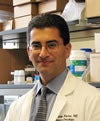Signal Transduction
 Some of the most exciting findings of the past decade have deciphered processes involved in biological signal transduction. These are processes by which cells communicate among themselves. Much is known about how cells detect the presence of hormones, contact with other cells, or the presence of nutrientsor other environmental signals, and how the cells respond to these signals by changing metabolism or gene expression. These studies have identified the role and nature of viral oncogenes, which, when expressed in a cell infected with a tumor virus, disrupt normal controls over growth properties and result in a transformed or tumor cell. These viral oncogenes are derived from normal cellular regulatory proteins, and this fact allowed deduction of the normal signaling pathways. The role of protein kinases and alterations in calcium levels in signalling pathways have been established, in part by contributions from researchers at the University of Virginia.
Some of the most exciting findings of the past decade have deciphered processes involved in biological signal transduction. These are processes by which cells communicate among themselves. Much is known about how cells detect the presence of hormones, contact with other cells, or the presence of nutrientsor other environmental signals, and how the cells respond to these signals by changing metabolism or gene expression. These studies have identified the role and nature of viral oncogenes, which, when expressed in a cell infected with a tumor virus, disrupt normal controls over growth properties and result in a transformed or tumor cell. These viral oncogenes are derived from normal cellular regulatory proteins, and this fact allowed deduction of the normal signaling pathways. The role of protein kinases and alterations in calcium levels in signalling pathways have been established, in part by contributions from researchers at the University of Virginia.
Ongoing research centers on the identification and characterization of proteins that participate in various central signaling pathways and the mechanism by which these proteins interact with or influence their targets, such as the cytoskeleton or specific gene expression. Our researchers study both the normal signaling pathways in response to hormones and other environmental signals, and the perturbation of these pathways in cancer cells. Numerous studies focus on the circulatory system and the molecular aspects of the control of blood pressure and muscle function.
Faculty

Casanova, James E.
Role of Arf family GTPases in vesicular transport and cytoskeleton assembly.
Cell Biology of bacterial pathogenesis.
The innate immune response to bacterial infection.

Hirsh, Jay
Molecular genetics; development and function of neurotransmitter-synthesizing neurons in Drosophila

Isakson, Brant
Translating our discoveries in the microcirculation to tangible benefits in patients.

Leitinger, Norbert
Role of lipid oxidation products in inflammation and vascular immunology in atherosclerosis and diabetes

Mohi, Golam
Cell signaling, stem cell biology, molecular and epigenetic mechanisms of blood and breast cancers

Owens, Gary K.
Identification of Factors and Mechanisms that Regulate the Stability of Late Stage Atherosclerotic Lesions and the Probability of Thromboembolic Events Including a Heart Attack or Stroke

Peirce-Cottler, Shayn M.
Tissue Engineering and Regeneration, Computational Systems Biology, Vascular Growth and Remodeling, Stem Cell Therapies

Perez-Reyes, Edward
Exploring epilepsy circuits then preventing seizures using gene therapies. Developing drug-inducible genetic switches for insulin replacement gene therapies.

Saucerman, Jeffrey J.
Roles of complex signaling networks involved in the regulation of cardiovascular function and disease

Stukenberg, P. Todd
Mechanisms of chromosome segregation in Mitosis and generation of Chromosomal Instability in tumors

Venton, B. Jill
Analytical Neurochemistry; Dopamine and Serotonin Neurotransmission in Drosophila; Mechanisms of rapid adenosine signaling in rodents

Winckler, Bettina
Endosomal function and dysfunction in neurons. Development of the nervous system: cytoskeleton and membrane traffic in axon and dendrite growth.

Wotton, David
Regulation of Gene Expression, Development and Tumor Progression by TGF beta Signaling




















